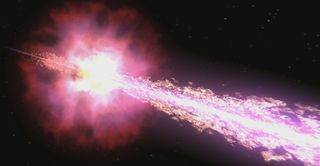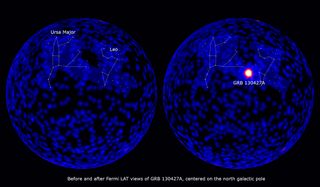It'll Be a Blast: Future Lasers May Mimic Space Explosions on Earth

Gamma-ray bursts — explosions lasting no more than a few minutes but that release more energy than the sun will emit in its lifetime — may be coming to Earth via the world's most powerful lasers.
Recreating the birth of a gamma-ray burst (on a scale that won't blow up the lab) isn't possible with current technology, but a group of researchers say new laser facilities coming online in the next few years will have that capability. These facilities could create beams of particles, which, when collided, would create high-energy gamma-rays via the same process that occurs in stellar explosions, black hole mergers and other extreme environments in nature.
"These are some of the most energetic events in the universe so we would like to understand what exactly happens there," said Frederico Fiuza, a staff scientist at SLAC National Accelerator Laboratory and one of the lead authors of the new study. [The 10 Biggest Gamma-Ray Blasts in Space]
Gamma-ray bursts may last for a few milliseconds, or a few minutes, but in that time they radiate such incredible bursts of energy they can be seen across the universe. A gamma-ray burst of 10 seconds will radiate more energy than our sun over 10 billion years.
"The energy involved in a gamma-ray burst is not something you can create in a lab," Fiuza said. "But the fundamental internal physics of a gamma-ray burst is something you can probe in the lab if you create the right conditions."
The cause of gamma-ray bursts remains a mystery. Evidence thus far points to energetic events like merging black holes, colliding neutron stars (collapsed stars with incredibly high density), or supernovas.
Fiuza said gamma-ray bursts aren't just fiery explosions. Most light in the universe is created through processes that involve heat, like the burning engine of a star. But gamma-ray bursts seem to be produced through a nonthermal process, which is extremely rare.
Get the Space.com Newsletter
Breaking space news, the latest updates on rocket launches, skywatching events and more!

In a new paper published in the journal Physical Review Letters, Fiuza and colleagues say next-generation laser facilities could create dense jets of particles that could be collided to create shockwaves. It's from those shockwaves that scientists think the incredibly energetic gamma-rays burst forth.
"The mystery here is how do these [particle jets] convert their energy into high-energy non-thermal radiation?" Fiuza said. "We know these jets are formed, and we know bright, short bursts of gamma-rays are emitted. What links them?"
Matter and light
Hui Chen, a physicist at Lawrence Livermore National Laboratory and Fiuza's co-lead author on the new paper, is already creating these particle jets in the laboratory. Using some of the most powerful lasers in the world, she and her colleagues shoot beams of focused light at a sheet of gold foil. The interaction of the laser light with the gold atoms produces unique particle pairs: one particle of matter (an electron) and one particle of antimatter (a positron).
Five years ago, Chen and her colleagues set the record for the amount of antimatter produced in a lab. Using three world-class laser facilities, they've now broken their own record by nearly two orders of magnitude.
To recreate the gamma-ray conditions in the lab, the number of matter/antimatter pairs in the jets must be incredibly high. Chen and Fiuza said current laser facilities can't produce the number of pairs that would be needed to probe the physics of gamma-ray bursts. But the new study is the first to show how much antimatter can be produced based on the energy of the laser. And the researchers conclude that facilities set to come online in coming years, like the National Ignition Facility’s Advanced Radiography Capability (ARC), will have the right capability to bring gamma-rays to the lab.
"What I think this paper did was draw up a road map that says, yes, if we have this condition, we will be able to make a mini gamma-ray burst experiment in the lab," Chen said.
"For me, it's just fascinating because what we are trying to do is use laser light [to] make matter and antimatter," Chen said. She notes that in the lab, this transfer of energy is "a huge effort," but in space, it seems to happen with ease. In nature, leading up to the production of the gamma-ray bursts, there are multiple processes that transfer or transform energy from photons to matter, and vice versa, with an ease that is enviable to scientists on Earth. It was Einstein's famous equation E=mc2 that showed that energy and mass are connected in this way.
"When we see those processes [in space], we appreciate how genius that equation is," Chen said.
Follow Calla Cofield @callacofield. Follow us @Spacedotcom, Facebook and Google+. Original article on Space.com.
Join our Space Forums to keep talking space on the latest missions, night sky and more! And if you have a news tip, correction or comment, let us know at: community@space.com.

Calla Cofield joined Space.com's crew in October 2014. She enjoys writing about black holes, exploding stars, ripples in space-time, science in comic books, and all the mysteries of the cosmos. Prior to joining Space.com Calla worked as a freelance writer, with her work appearing in APS News, Symmetry magazine, Scientific American, Nature News, Physics World, and others. From 2010 to 2014 she was a producer for The Physics Central Podcast. Previously, Calla worked at the American Museum of Natural History in New York City (hands down the best office building ever) and SLAC National Accelerator Laboratory in California. Calla studied physics at the University of Massachusetts, Amherst and is originally from Sandy, Utah. In 2018, Calla left Space.com to join NASA's Jet Propulsion Laboratory media team where she oversees astronomy, physics, exoplanets and the Cold Atom Lab mission. She has been underground at three of the largest particle accelerators in the world and would really like to know what the heck dark matter is. Contact Calla via: E-Mail – Twitter
